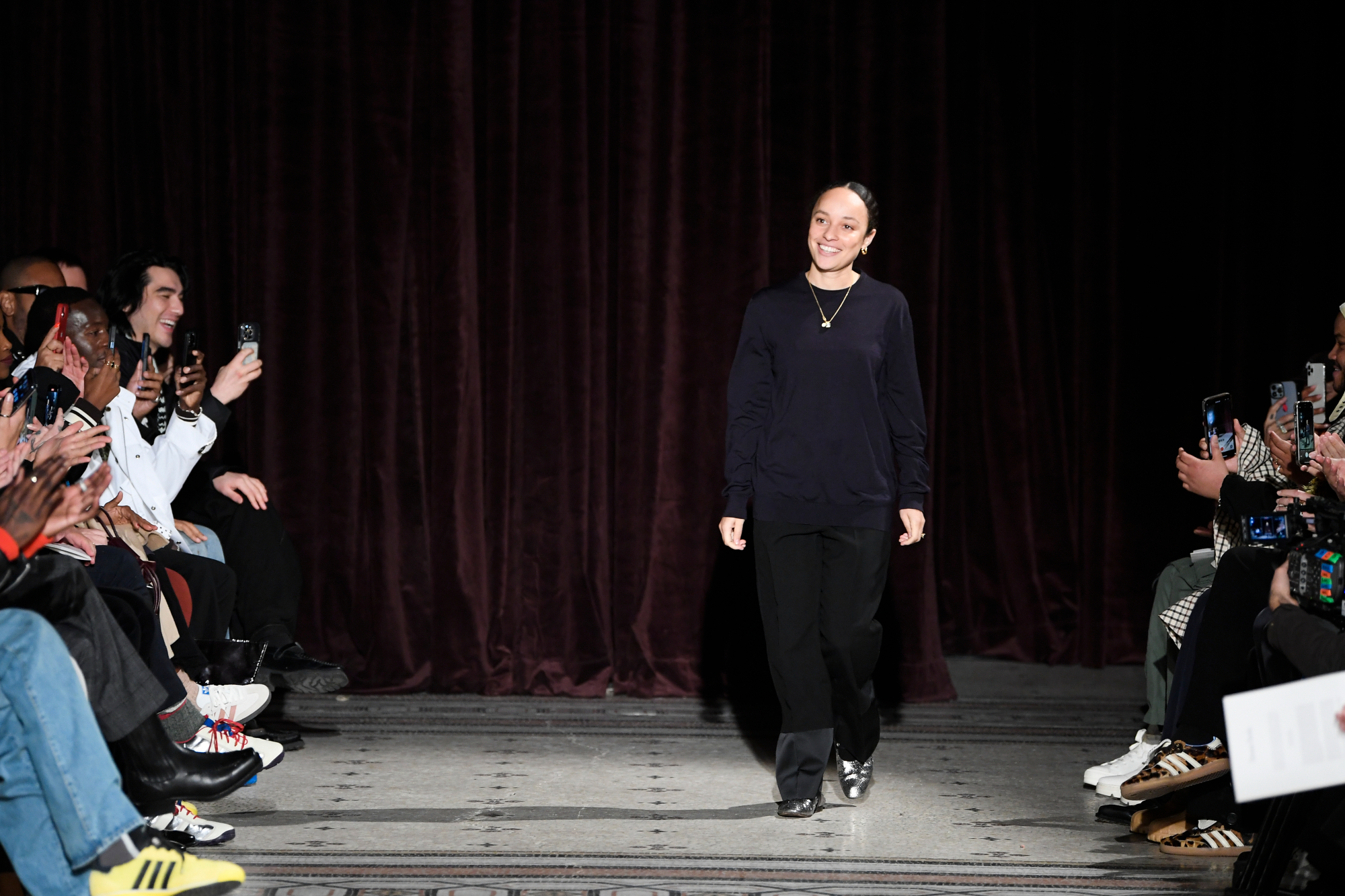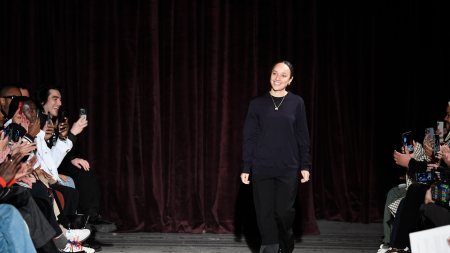
For the past decade, Grace Wales Bonner has embraced a multiplicity of perspectives in the creation of her award-winning eponymous brand, which draws from intensive archival research to create an expansive world of storytelling. The multihyphenate British fashion designer fuses the philosophical with the political in the making of works in a variety of mediums, including textile, sound, performance, sculpture, and text. In doing so, Wales Bonner has introduced a unique approach to luxury by combining the Afro-Atlantic spirit with European heritage. This approach can also be seen in her latest endeavor, “Spirt Movers,” an exhibition she co-curated at the Museum of Modern Art in New York as part of the institution’s famed Artist’s Choice series.
“She sees research as a spiritual and artistic endeavor, one that informs her polymathic practice, which extends to publications, performance, writing, film, and beyond,” Michelle Kuo, a chief curator at large at MoMA who worked with Wales Bonner on the exhibition, told ARTnews.
For the exhibition, on view until April 7, Wales Bonner has taken over part of MoMA’s first-floor galleries, showcasing a collection of 50 artworks with a focus on Black aesthetic and cultural practices inspired by the sounds, styles, and experiences of the African diaspora.
Each of the displays epitomizes the title of the show which Wales Bonner has said “evoke multiple histories, inspire contemplation, and conjure new connections between people and Places.” Works featured in the show come from an array of artists, including Terry Adkins, Betye Saar, Moustapha Dimé, David Hammons, and even the likes of Agnes Martin and Henri Cartier-Bresson.
A recurring theme in the exhibition is a certain musicality, best exemplified by Adkin’s large-scale installation Last Trumpet (1995). Its four eye-catching, elegantly shaped trumpets stand tall at the far side of the first gallery and immediately draw you toward them. These 18-foot-long horns are functional musical instruments, part of Adkin’s aim to connect the worlds of music, sculpture, and performance, like Wales Bonner’s intention in bridging fashion with other creative disciplines.

Literature is just one point of reference for Wales Bonner. Creating worlds for characters to inhabit through different fabric textures, sounds, rhythm, and movement. She has said that fashion is an immediate form of communication to an audience where she can explore deep ideas. Wales Bonner’s practice is also informed by her extensive archival research, which lends each project a holistic approach that aims to create worlds for posterity. One such work is a hard-to-miss wooden carving by Moustapha Dimé titled Lady with a Long Neck (1992) that combines found materials (both organic and industrial) collected from the streets of Dakar. In its raw form, the sculpture bridges Islamic and Sufi spirituality with artistic handiwork.
On view for the first time is David Hammons’s makeshift scroll Afro Asian Eclipse (or Black China), from 1978, which is a reference to Duke Ellington’s 1971 album The Afro-Eurasian Eclipse. In using the form of an East Asian scroll that has at its center a cluster of hair collected from barbershop floors, the work highlights the connection between Afro-Pacific and Afro-Atlantic culture.
“Many works in the show make use of found materials—things that have a history, that have had other lives,” Kuo said. “Moustapha Dimé’s Lady with a Long Neck features a reclaimed butcher’s block at its center, with a rhythmic array of notches that are actually the marks made by cooks who had used the wooden block in Dakar.”

She continued, “There’s a beautiful rhythm, too, in the carefully patterned tufts of hair woven into David Hammons’s Afro-Asian Eclipse, which the artist collected from the floors of barber shops. You can see the trace of hands, of meditative motions, of a different kind of musicality in each piece.”
But, Wales Bonner sees curating art exhibitions as an extension of her work as a fashion designer. Her first exhibition “A Time for New Dreams,” which borrowed its title from a collection by Nigerian British poet Ben Okri, was staged at London’s Serpentine Gallery in 2019. Its themes focused on mysticism, magical realism, and ritual within Black cultural and aesthetic practices and looked at the ideas of shrines across the Black Atlantic.
Showcasing sculpture, film, photography, literature, music, poetry, performances, and more, the multisensory installation show brought together a group of artists including Rashid Johnson, Paul Mpagi Sepuya, Eric N. Mack, Kapwani Kiwanga, and Liz Johnson Artur, who has since become a frequent collaborator. In the show’s catalogue, Okri says of Wales Bonner’s research-focused practice, “We ought to use time like emperors of the mind. Do magic things that the future surprised will find.”
Claude Adjil, the exhibition’s curator, said that in early conversations with Wales Bonner, she mentioned Robert Farris Thompson’s landmark 1983 book Flash of the Spirit: African and Afro-American Art & Philosophy, which looks at five African civilizations (Kongo, Yoruba, Mande, Cross River, and Ejagham) and how they have impacted the social, aesthetic and metaphysical traditions and creative output of Black people across the African diaspora. “We were looking at different books but also artists that have inspired her,” Adjil said.
But beyond just presenting a static exhibition with works on view, Wales Bonner thought about how to create a show that could be activated and could come alive through a performance program, including an evening with British musician and songwriter Sampha, whom Wales Bonner has previously collaborated with for a zine Shy Light (2017) and the soundtrack to her Autumn/Winter 2017 show. “Grace holds space for these different collaborations,” Adjil said.
Recurring themes in her practice, both as a designer and as a curator, are the intergenerational artistic production of Black people across the diaspora. Just as Okri’s poetry collection lent its title to her Serpentine show, Ishmael Reed’s 1972 seminal book Mumbo Jumbo gave her Autumn/Winter 2019 collection its title, and her research for one project often leads to the next, as Okri led her to Reed. Set in 1920s New York, Mumbo Jumbo follows a series of narratives surrounding jazz music, white supremacy, and voodoo in a collage-style approach. In a statement accompanying the collection, Wales Bonner said, “The collection considers the role of writers as oracles, connecting to a rich and magical lineage, serving as the custodians of ancestral wisdom passed down and reinterpreted.”
For each of Wales Bonner’s boundary-pushing projects, there is a different themebut, according to Adjil, “they’re building blocks in what she has been looking at across over the years.” Such was the case with Johnson Artur, whom Wales Bonner met during a studio visit during the research phase of “A Time for New Dreams.” “We went to her studio and there was a lot of rich and ongoing dialogue, talking about what had inspired her and what she was thinking about for her design collection,” Adjil recalled.
Johnson Artur added, “I have been working on my ongoing art project Black Balloon Archive for the last 30 years and have never compromised on my idea to create a space where the people I photograph can see themselves through their own self. I like to believe this was the reason Grace approached me for the first time for her curated show at the Serpentine.”
Those conversations ultimately laid the groundwork for what would become Wales Bonner’s “Mumbo Jumbo” collection, which featured an assortment of characters, ranging from a West African spiritual healer to an artist shaman. Also included in the cast were intellectuals from Howard University, who dressed in the classic American college wardrobe consisting of wide leg jeans and trousers, oxford and polo shirts, and jazz-era tuxedos.
“I’ve been thinking about black intellectualism as a form of spirituality,” Wales Bonner told AnOther Magazine in an interview at the time. “It’s referencing very recognisable clothing – American college – but trying to imbue that with a sense of magic that originates from African spirituality; imbuing something that’s very classic and American and with a sense of language and culture that comes from somewhere else.”
Wales Bonner and Johnson Artur would collaborate again for the designer’s Autumn/Winter 2020 collection Lovers Rock, which Johnson Artur photographed. The collection was a celebration of the reggae genre of the same name that emerged from the British Afro-Caribbean underground parties of the 1970s. Serving as a love letter to Caribbean music and fashion, the partnering with Johnson Artur was symbiotic, as she has documented the African diaspora for over three decades from underground clubbing scenes to street life, from church celebrations to everyday moments.
“Art has no boundaries—I believe Grace shares this vision too,” Johnson Artur said. “Collaborating is an essential part of my practice and each one has been a highlight in my career.”

Alongside the MoMA exhibition, there is also a mixtape on Spotify where Wales Bonner takes us on a journey of soundscapes through the exhibition, and an artist’s book, titled Dream in the Rhythm—Visions of Sound and Spirit, created and edited by her as a “an archive of soulful expression,” featuring photographs, texts, poems, and more by authors and artists including Reed, June Jordan, Nikki Giovanni, Lynette Yiadom-Boakye, Langston Hughes, and Quincy Troupe.
“Grace Wales Bonner has changed the way we see style—not only as surface but as
structure,” Kuo said. “Every detail of her polymathic designs, publications, exhibitions, and films is related to long histories, deep archives, and cultural identities across the diasporic world.”
An Introduction to Artist Julien Nguyen, the Latest Inspiration for Fashion Powerhouse Loewe
How Art and Fashion Collaborations Have Evolved Over the Decades

How to Make a Black Manhattan, a Rule-Breaking Twist on the Classic Whiskey Cocktail

‘Oppenheimer’ Honored at Saint Laurent and Vanity Fair Party, With Cillian Murphy, Hailey Bieber, Zoë Kravitz and Channing Tatum

How to view and search episode transcripts on Apple Podcasts

Matthew McConaughey in Back of Police Car: Day 1 of SXSW Sports


